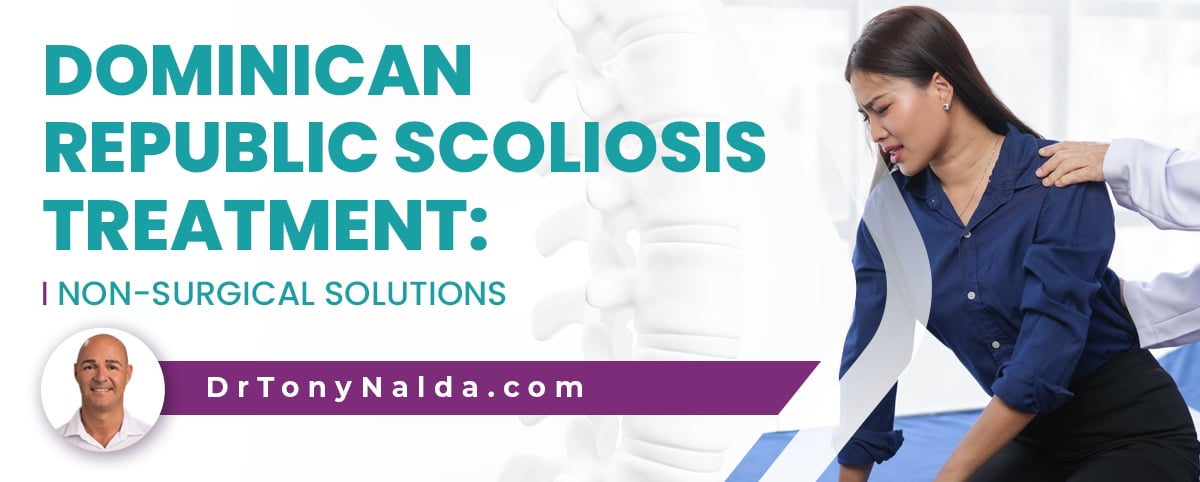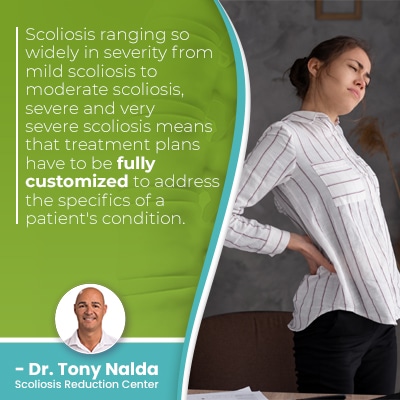Dominican Republic Scoliosis Treatment: Non-Surgical Solutions

Treatment providers who offer a unique approach and impressive results can be worth traveling for. Residents of the Dominican Republic have only a 3-hour flight to Orlando, Florida to access scoliosis treatment from one of the nation's leading non-surgical treatment centers: the Scoliosis Reduction Center®.
Developing countries don't always have the same level of access to medical professionals who specialize in scoliosis treatment, so travel might be necessary for those looking for specific results.
Table of Contents
Why is Scoliosis Complex to Treat?
Scoliosis is often described as a complex condition, and there are a few reasons for this.
While there are a number of spinal conditions that cause a loss of its healthy curves, scoliosis has some unique characteristics that set it apart; scoliosis causes the spine to bend unnaturally to the side and twist, making it a 3-dimensional spinal condition.
A rotational component and a minimum Cobb angle of 10 degrees is needed to reach a diagnosis of scoliosis, and the condition is diagnosed through a combined physical examination and X-ray results.
Condition Severity
 Cobb angle takes us to the next reason that scoliosis can be complex to treat; it ranges so widely in severity.
Cobb angle takes us to the next reason that scoliosis can be complex to treat; it ranges so widely in severity.
Condition severity is determined by a measurement known as Cobb angle, and this is taken during X-ray and involves drawing lines from the tops and bottoms of the curve's most-tilted vertebrae, and the resulting angle is expressed in degrees.
The higher a patient's Cobb angle, the more severe the condition, and the more likely it is that its effects are going to be noticeable.
Scoliosis ranging so widely in severity from mild scoliosis to moderate scoliosis, severe and very severe scoliosis means that treatment plans have to be fully customized to address the specifics of a patient's condition.
Scoliosis is a Progressive Condition
Not only does scoliosis range widely in severity, it is also a progressive condition, meaning its nature is to get worse over time.
So part of the complexity of scoliosis treatment is counteracting its progressive nature, particularly in children because it's growth that triggers progression.
We don't always know what causes the initial development of scoliosis, but we do understand what triggers its progression, and this involves growth spurts, which is why scoliosis in children and young adults always needs to be taken seriously and treated proactively.
The nature of scoliosis is to get worse, so where a patient's scoliosis is at the time of diagnosis doesn't mean that's where it will stay; even scoliosis diagnosed as mild can easily progress and become moderate, severe, and very severe scoliosis, particularly if left untreated, or not treated proactively.
There are also different types of scoliosis that have unique characteristics and treatment needs.
Different Types of Scoliosis
There are different types of scoliosis, and condition type is determined by causation.
The majority of scoliosis cases involve idiopathic scoliosis meaning cause unknown, and idiopathic scoliosis accounts for approximately 80 percent of known cases, but the remaining 20 percent are associated with known causes and are considered atypical.
Neuromuscular Scoliosis Treatment
A condition's underlying cause has to be the focus of treatment, when known, and with neuromuscular scoliosis, the cause is the presence of a larger neuromuscular condition such as cerebral palsy, muscular dystrophy, or spina bifida.
This complicates the treatment process because scoliosis has developed as a secondary complication of a larger medical issue, so the larger issues need to be the primary focus of treatment.
Congenital Scoliosis Treatment
Congenital scoliosis treatment can be a challenge because of the age of the patient; babies are born with congenital scoliosis that develops in utero due to a malformed spine, and this is a rare type affecting approximately 1 in 10,000.
Degenerative Scoliosis Treatment
Degenerative scoliosis affects older adults and is caused by natural age-related spinal degeneration, and the challenge of treatment is that you're dealing with spines that are becoming increasingly unbalanced and unstable, not just due to the scoliosis, but also because of natural degenerative changes.
So neuromuscular scoliosis, degenerative, and congenital scoliosis are atypical types of scoliosis because they are associated with known causes, and in addition, in typical idiopathic scoliosis cases, curves bend to the right, away from the heart, but in atypical cases, curves can bend to the left, towards the heart.
When I see a left-bending curve on an X-ray, I know there is an underlying pathology behind the development of the condition, and this is a red flag that there will be unique treatment challenges.
Non-Surgical Treatment Options
 Considering the complexities of scoliosis and how much variance there is between cases, treatment plans need to be fully customized and crafted by a specialist; the complexities of scoliosis and scoliosis treatment are beyond the scope of general medical care.
Considering the complexities of scoliosis and how much variance there is between cases, treatment plans need to be fully customized and crafted by a specialist; the complexities of scoliosis and scoliosis treatment are beyond the scope of general medical care.
So for those in the Dominican Republic looking for scoliosis treatment, traveling to Orlando, Florida with a 3-hour flight can mean accessing the expertise and experience of Dr. Tony Nalda, author of Scoliosis Hope and creator of the Scoliosis Reduction Center®.
The Center is unique because its focus is a multifaceted approach that combines the power of different treatment disciplines, all accessible under one roof, so while some patients have to travel initially, once a patient, they benefit from the accessibility of multiple corrective treatment disciplines.
While there is always the traditional scoliosis treatment option of spine surgery, doctors who specialize in scoliosis can also offer non-surgical techniques that are less costly, invasive, and healthier for the spine.
Reducing the Curve
When it comes to impacting the underlying structural nature of scoliosis, condition-specific chiropractic care can help by manually adjusting the position of the curve's most-tilted vertebrae back into alignment with the rest of the spine.
Reducing the curve is going to be beyond the reach of general chiropractic care and going to require the type of specialized training experience Dr. Tony can offer.
Physical Therapy and Scoliosis Exercises
When it comes to the spine's ability to maintain its natural curves and alignment, its surrounding muscle health is a factor.
Core muscle strength and balance can be affected by scoliosis, and the spine needs strong surrounding muscles for optimal support and stability.
Physical therapy and scoliosis exercises, when prescribed by a scoliosis-specific therapist, can help increase muscle strength, improve posture, and address any related muscular imbalance.
An unnaturally-curved spine doesn't just affect the spine, but also its surrounding muscles and nerves.
The muscles on one side of the spine are overworked trying to counteract the unnatural curve's uneven forces, and the muscles on the opposite side become weak from underuse; this can cause increasing postural changes and painful muscle spasms.
Patients who perform scoliosis-specific exercises as they are prescribed can benefit in a number of ways, including increasing spinal strength and flexibility, making it more responsive to treatment, and improving the spine's surrounding muscle strength and balance.
Treatment success can also involve scoliosis bracing capable of augmenting corrective treatment results by pushing the spine into a healthier position and alignment.
Conclusion
When the spine's healthy curves are in place, its vertebrae are aligned in a straight and neutral position as they should be, and this makes the spine stronger, more flexible, and better able to handle mechanical stress incurred during movement.
A structural spinal disorder needs to primarily be impacted on a structural level, and this is why non-surgical scoliosis treatment is chiropractic-centered.
For residents of the Dominican Republic, a 6-hour flight to a premier holiday destination for many, the Scoliosis Reduction Center's impressive results are within reach.
Dr. Tony has been providing a non-surgical scoliosis treatment alternative for 25+ years, and in that time has helped improve quality of life for many patients.
Conservative treatment preserves as much of the spine's natural strength and function as possible, offering patients a uniquely proactive and integrative approach to managing their condition for long-term sustainable treatment results.
There are never treatment guarantees, but particularly with early detection and intervention, there are fewer limits to what non-surgical scoliosis treatment can achieve.
Surgeons who treat scoliosis do so with advanced surgical techniques that involve spinal fusion, but all surgical procedures come with their share of risks, and spinal surgery can be particularly risky.
As the spine and brain work in tandem to form the central nervous system, spinal conditions like scoliosis can affect the body in a number of ways, and the best way to minimize condition effects is to treat it proactively.
So for anyone interested in what non-surgical scoliosis treatment can offer, it can be as simple as scheduling a consultation with the Center.
Dr. Tony Nalda
DOCTOR OF CHIROPRACTIC
After receiving an undergraduate degree in psychology and his Doctorate of Chiropractic from Life University, Dr. Nalda settled in Celebration, Florida and proceeded to build one of Central Florida’s most successful chiropractic clinics.
His experience with patients suffering from scoliosis, and the confusion and frustration they faced, led him to seek a specialty in scoliosis care. In 2006 he completed his Intensive Care Certification from CLEAR Institute, a leading scoliosis educational and certification center.
About Dr. Tony Nalda
 Ready to explore scoliosis treatment? Contact Us Now
Ready to explore scoliosis treatment? Contact Us Now





